Crownhill Fort
- North Caponier - Caponiers are the spaces in the lower levels
of the Fort that protrude out into the dry moat. Originally they would
have housed cannons that would have fired case shot - a metal canister
that would have contained metal balls. The guns would have been fired in
defence of an enemy attack and the canisters would have split upon leaving
the gun showering their contents along the length and width of the moat.
|
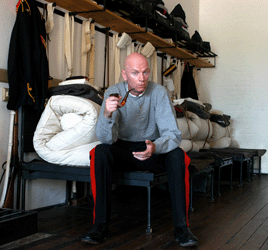 David
Doyle - David is originally from Ireland, and was brought up in
a tradition steeped in tales of Tír Na nÓg, the Tuatha de
Danaan, and the the warriors of the Fianna. He studied theatre at Dartington,
and has performed with a number of Westcountry-based theatre companies.
He now lives in Plymouth and regularly appears at Stone Soup storytelling
events. He loves to create characters, and to drop them into a web of stories
so that his audience, settling into a beginning they think they know well,
are surprised when the narrative suddenly jumps across centuries and continents
and, perhaps, even into an entirely different story. David
Doyle - David is originally from Ireland, and was brought up in
a tradition steeped in tales of Tír Na nÓg, the Tuatha de
Danaan, and the the warriors of the Fianna. He studied theatre at Dartington,
and has performed with a number of Westcountry-based theatre companies.
He now lives in Plymouth and regularly appears at Stone Soup storytelling
events. He loves to create characters, and to drop them into a web of stories
so that his audience, settling into a beginning they think they know well,
are surprised when the narrative suddenly jumps across centuries and continents
and, perhaps, even into an entirely different story.
David is pictured here, dressed in the uniform of a Victorian soldier,
telling stories in the Victorian Barrack-Room at Crownhill
Fort. (Photograph © Martina
Rooney @ eyecon photographics)
|
Art Garden Café
- The café was for many years an antique shop, until it was destroyed
by fire about five years ago. During the refurbishment the ground floor
was turned into a café, and the first floor into an artist's studio
and exhibition space. The studio is currently occupied by Barbican-based
artist Keith Collins.
|
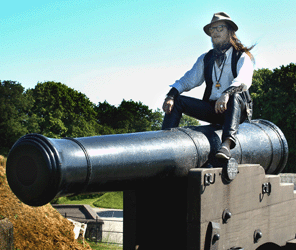 Nik
Brooks - Nik lives on Plymouth's Barbican. He is a storyteller,
actor, writer & musician. His informal, relaxed style of storytelling
explores his love of folk tales, myth and legend. He presents the characters
in his stories in a down to earth way, so that we can identify with them
on a human level, without losing the magic or significance of the tales.
He is fascinated with the most ancient tales, and the transmutation they
have made in their journey across aeons and cultures. He aims to make such
stories accessible by having fun telling them.
Nik
Brooks - Nik lives on Plymouth's Barbican. He is a storyteller,
actor, writer & musician. His informal, relaxed style of storytelling
explores his love of folk tales, myth and legend. He presents the characters
in his stories in a down to earth way, so that we can identify with them
on a human level, without losing the magic or significance of the tales.
He is fascinated with the most ancient tales, and the transmutation they
have made in their journey across aeons and cultures. He aims to make such
stories accessible by having fun telling them.
Nik is pictured here astride one of the cannon on the ramparts of Crownhill
Fort. (Photograph © Martina
Rooney @ eyecon photographics)
|
Crownhill Fort
- Moncrieff Emplacement - This gun emplacement would have held a
‘Moncrieff Counterweight Disappearing Cannon’. An example can be seen on
the North-East side of the Fort. Only 65 of this type of cannon were made
in the 1860s and 70s, and two were mounted at Crownhill at a time when
the Fort was fully armed in the 1890s.
|
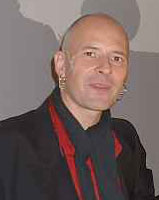 Ben Haggarty - Since 1981, Ben has been one of the prime movers
of the revival of the art of professional storytelling in Britain. He is
internationally respected for both his tellings of traditional tales to
adults and children, and for his knowledge and understanding of stories,
and of diverse storytelling traditions. Equipped with an extensive repertoire
of over 350 traditional narratives, that range from 2 minute jests and
folktales to 2 hour long fragments of Epic Mythology, he explores many
themes, evoking many moods.
Ben Haggarty - Since 1981, Ben has been one of the prime movers
of the revival of the art of professional storytelling in Britain. He is
internationally respected for both his tellings of traditional tales to
adults and children, and for his knowledge and understanding of stories,
and of diverse storytelling traditions. Equipped with an extensive repertoire
of over 350 traditional narratives, that range from 2 minute jests and
folktales to 2 hour long fragments of Epic Mythology, he explores many
themes, evoking many moods. |
Crownhill Fort
- Detention Room - This room contains two cells that would have
been occupied by members of the garrison of the Fort that had offended.
The cells did not necessarily contain just one Gunner; on occasions they
might have been filled with a greater number. Once the Gunner had spent
an uncomfortable night in the cell he would have been ‘released’ the next
day to be detailed with jobs such as cleaning out the cannons and mucking
out the stables!
|
 Andria
Hooper-Threadgill - Andria is a theatre graduate. She lived in Cornwall
for many years, and has worked with the Cornish Theatre Collective, and
Kneehigh Theatre Company. She has also been a resident Storyteller at the
Eden Project, where she created stories reflecting the importance of plants
in our everyday lives - "We wear, eat and drink them, use them for shelter,
to heal, beautify, and perfume ourselves. They even make the air we breathe."
She is now based in Salisbury in Wiltshire.
Andria
Hooper-Threadgill - Andria is a theatre graduate. She lived in Cornwall
for many years, and has worked with the Cornish Theatre Collective, and
Kneehigh Theatre Company. She has also been a resident Storyteller at the
Eden Project, where she created stories reflecting the importance of plants
in our everyday lives - "We wear, eat and drink them, use them for shelter,
to heal, beautify, and perfume ourselves. They even make the air we breathe."
She is now based in Salisbury in Wiltshire. |
 Tudor
Rose Tea Rooms & Garden - The Tea Rooms are situated in
historic New Street in a building that dates back to around 1640. The original
17th century oak staircase is still in place. It was originally a merchant's
house. Tudor
Rose Tea Rooms & Garden - The Tea Rooms are situated in
historic New Street in a building that dates back to around 1640. The original
17th century oak staircase is still in place. It was originally a merchant's
house.
|
 Don Newton - Don has been a full-time storyteller since 1987, working
mainly in Westcountry schools, but also quite a lot for English Heritage
and National Trust. He tells only traditional tales from a variety of cultures;
folk-tales, fairy-tales, myths, and legends. He is firmly committed to
the belief that through listening to stories, well told, children will
absorb a greater vocabulary and increase their communication skills, as
well as having a great time.
Don Newton - Don has been a full-time storyteller since 1987, working
mainly in Westcountry schools, but also quite a lot for English Heritage
and National Trust. He tells only traditional tales from a variety of cultures;
folk-tales, fairy-tales, myths, and legends. He is firmly committed to
the belief that through listening to stories, well told, children will
absorb a greater vocabulary and increase their communication skills, as
well as having a great time. |
Crownhill Fort
- Main Magazine - This room was the main store for over 900 tonnes
of gunpowder in Victorian times. Originally the powder came in barrels
and the cartridges would have then been made up individually and stored
in boxes within large racks. In later times the cartridges would have come
ready made.
|
 Peter Oswald - Peter is a playwright and performer, and writer-in-residence
at the Globe Theatre in London. His plays, in verse and prose, have been
performed at the National Theatre, the Barn Theatre in Dartington, the
Globe, and all around the world. He will be performing some of his story
poems based on Italian folktales about such things as a young man sold
to the devil and rescued by a fairy in the shape of an eagle, a love affair
between the son of an ogress and the daughter of a shoemaker, and a magic
sack. He has performed his stories already at the Rose Theatre in Southwark,
the Art Garden Cafe in Plymouth, the Fat Lemons Cafe and the Royal Seven
Stars in Totnes.
Peter Oswald - Peter is a playwright and performer, and writer-in-residence
at the Globe Theatre in London. His plays, in verse and prose, have been
performed at the National Theatre, the Barn Theatre in Dartington, the
Globe, and all around the world. He will be performing some of his story
poems based on Italian folktales about such things as a young man sold
to the devil and rescued by a fairy in the shape of an eagle, a love affair
between the son of an ogress and the daughter of a shoemaker, and a magic
sack. He has performed his stories already at the Rose Theatre in Southwark,
the Art Garden Cafe in Plymouth, the Fat Lemons Cafe and the Royal Seven
Stars in Totnes.
Photograph © Martina
Rooney @ eyecon photographics
|
Crownhill Fort
- Gun Emplacement - The covered emplacements on the ramparts would
have contained a 110-pounder breech loading cannon. The gunpowder cartridges
and the shells for these guns were stored beneath the cannons in magazines
and a hoist would have lifted the supplies to the gun when required for
firing.
|
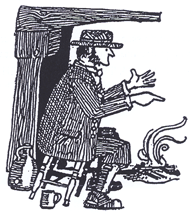 Clive
Fairweather - Clive spent 30 years as a teacher of English and History.
He has worked extensively with English Heritage and The National Trust
on historical interpretation projects, sometimes performing as ‘Old Fairweather’,
a 19th century farm labourer, or as ‘Augustus Hare’, the notable Victorian
storyteller. He offers living interaction with the past, and stories that
convey the hopes, dramas, terrors, and delights of other times. He has
a dazzling repertoire of tales and, with the twin strategies of laughter
and argument, he gets children thinking and talking seriously. Clive
Fairweather - Clive spent 30 years as a teacher of English and History.
He has worked extensively with English Heritage and The National Trust
on historical interpretation projects, sometimes performing as ‘Old Fairweather’,
a 19th century farm labourer, or as ‘Augustus Hare’, the notable Victorian
storyteller. He offers living interaction with the past, and stories that
convey the hopes, dramas, terrors, and delights of other times. He has
a dazzling repertoire of tales and, with the twin strategies of laughter
and argument, he gets children thinking and talking seriously. |
Crownhill Fort
- Victorian Barrack Room - This room was home to 20 Gunners in the
1890s. This was the Gunners' home and they would have ate, slept,
changed their clothes and socialised all together in a very confined space.
The bed of a Gunner was in two parts. The legs on the foot of the
bed were on wheels so it could roll back under the head and once the mattress
had been rolled up it could then double as an armchair, offering the men
more space when they were in the room during the day.
|
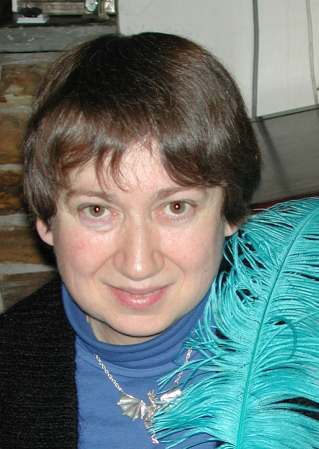 Jill Lamede - Jill is a storyteller, writer, and actor. She is the
resident storyteller at the Camelot Castle Hotel in Tintagel; "pick a story
from the story-basket, listen, and the words will carry you away to a land
of imagination." She has written a number of books, including 'Tales of
the Tintagel Dragon', which explains many of the actual unusual events
that have occurred around Tintagel, and that part of the Cornish coast,
over the years. - Why is the roof of Tintagel’s Old Post Office so curvy?
Why is there a hole in the waterfall at St Nectan’s Glen? What caused the
plane crash in Tintagel in 1979? The answer to all these questions is:
The Tintagel Dragon did it! - She has also produced a CD entitled 'Stories
from the Tintagel Storyteller', and containing tales of wonder and magic
for all the family.
Jill Lamede - Jill is a storyteller, writer, and actor. She is the
resident storyteller at the Camelot Castle Hotel in Tintagel; "pick a story
from the story-basket, listen, and the words will carry you away to a land
of imagination." She has written a number of books, including 'Tales of
the Tintagel Dragon', which explains many of the actual unusual events
that have occurred around Tintagel, and that part of the Cornish coast,
over the years. - Why is the roof of Tintagel’s Old Post Office so curvy?
Why is there a hole in the waterfall at St Nectan’s Glen? What caused the
plane crash in Tintagel in 1979? The answer to all these questions is:
The Tintagel Dragon did it! - She has also produced a CD entitled 'Stories
from the Tintagel Storyteller', and containing tales of wonder and magic
for all the family. |
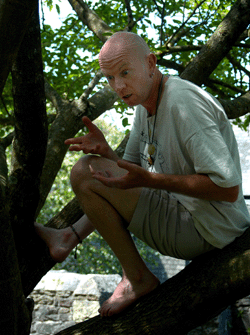 Elizabethan
Gardens - The gardens are situated to the rear of a number of
properties in New Street owned and managed by the Barbican Association,
a charity whose remit is to acquire, restore, and maintain buildings of
historic interest. Elizabethan
Gardens - The gardens are situated to the rear of a number of
properties in New Street owned and managed by the Barbican Association,
a charity whose remit is to acquire, restore, and maintain buildings of
historic interest.
David Doyle is pictured here telling stories from the Mulberry Tree
in the Elizabethan Gardens. (Photograph
© Martina Rooney @
eyecon
photographics)
|
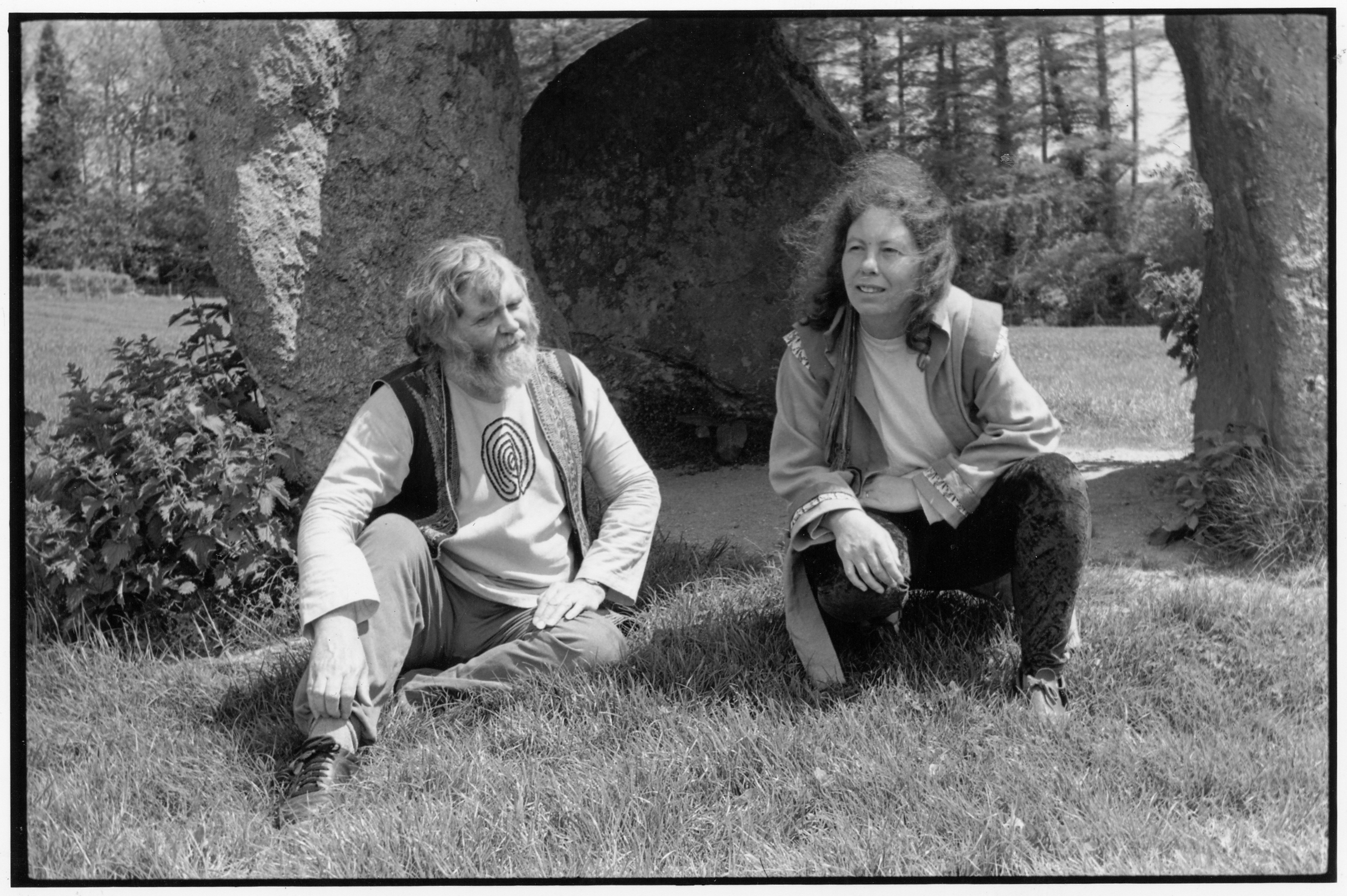 Michael Dacre - Michael started storytelling in 1988, following
a series of workshops with 'The Company of Storytellers'. Soon after he
became the resident storyteller at The Beaford Arts Centre in North Devon.
He tells traditional tales in a powerful, lively and literary style, that
is entertaining and well-researched, embracing a love of language and strong
narrative, sometimes scary, often hilarious and usually both. His
hoard of stories - currently around 450 - is mainly British and European
but he also tells Native American stories and tales from other cultures
too. Michael is sometimes accompanied, musically, by his wife Wendy (pictured),
but will be flying solo at this event.
Michael Dacre - Michael started storytelling in 1988, following
a series of workshops with 'The Company of Storytellers'. Soon after he
became the resident storyteller at The Beaford Arts Centre in North Devon.
He tells traditional tales in a powerful, lively and literary style, that
is entertaining and well-researched, embracing a love of language and strong
narrative, sometimes scary, often hilarious and usually both. His
hoard of stories - currently around 450 - is mainly British and European
but he also tells Native American stories and tales from other cultures
too. Michael is sometimes accompanied, musically, by his wife Wendy (pictured),
but will be flying solo at this event. |
Crownhill Fort
- Cookhouse (Education Centre) - A Gunner's staple diet was of meat
and bread. Any further supplements, such as vegetables, were bought himself
with his own money, or grown in small gardens outside of the Fort. The
Cooks boiled up the cuts of meat in water in large pots on huge ranges.
|
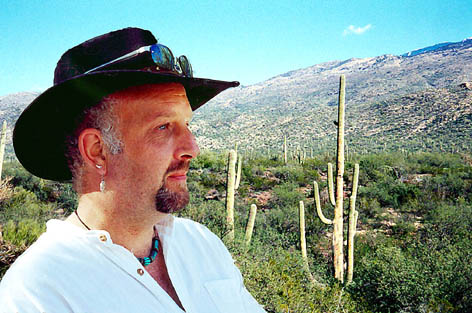 Graham -Teller of Tales - Graham has a background in youth work
and education, using story to explain and challenge. He is a storyteller
of fire and energy, exploring myths and legends from his native Cornwall,
and across the globe, alongside his own wondrous creations. His dramatic
style and vivid imagery draw an expectant hush from the audience as they
journey through fantastical lands. Prepare to be transported to a time
of dragons, the legends of the Iroquois, through ancient Celtic myths,
and amazing realms of his own invention.
Graham -Teller of Tales - Graham has a background in youth work
and education, using story to explain and challenge. He is a storyteller
of fire and energy, exploring myths and legends from his native Cornwall,
and across the globe, alongside his own wondrous creations. His dramatic
style and vivid imagery draw an expectant hush from the audience as they
journey through fantastical lands. Prepare to be transported to a time
of dragons, the legends of the Iroquois, through ancient Celtic myths,
and amazing realms of his own invention. |
Crownhill Fort
- WWII Barrack Room - In the early 1900s a law was passed where
the number of soldiers in barracks was greatly reduced. This saw the room
now have a maximum of 13 men accommodated in it. During WWII Crownhill
Fort was regarded as a first class position of enemy resistance and had
anti aircraft guns positioned within it. As a result of German intelligence
it is believed that they knew that their aircraft would have been under
threat should they have flown over the Fort. Crownhill survived intact
during the bombing raids on Plymouth during the Second World War.
|
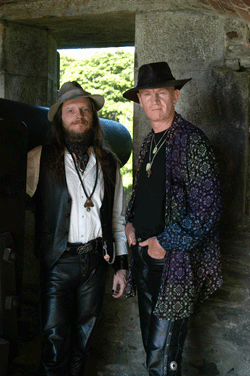
 David
Doyle - David is originally from Ireland, and was brought up in
a tradition steeped in tales of Tír Na nÓg, the Tuatha de
Danaan, and the the warriors of the Fianna. He studied theatre at Dartington,
and has performed with a number of Westcountry-based theatre companies.
He now lives in Plymouth and regularly appears at Stone Soup storytelling
events. He loves to create characters, and to drop them into a web of stories
so that his audience, settling into a beginning they think they know well,
are surprised when the narrative suddenly jumps across centuries and continents
and, perhaps, even into an entirely different story.
David
Doyle - David is originally from Ireland, and was brought up in
a tradition steeped in tales of Tír Na nÓg, the Tuatha de
Danaan, and the the warriors of the Fianna. He studied theatre at Dartington,
and has performed with a number of Westcountry-based theatre companies.
He now lives in Plymouth and regularly appears at Stone Soup storytelling
events. He loves to create characters, and to drop them into a web of stories
so that his audience, settling into a beginning they think they know well,
are surprised when the narrative suddenly jumps across centuries and continents
and, perhaps, even into an entirely different story.
 Nik
Brooks - Nik lives on Plymouth's Barbican. He is a storyteller,
actor, writer & musician. His informal, relaxed style of storytelling
explores his love of folk tales, myth and legend. He presents the characters
in his stories in a down to earth way, so that we can identify with them
on a human level, without losing the magic or significance of the tales.
He is fascinated with the most ancient tales, and the transmutation they
have made in their journey across aeons and cultures. He aims to make such
stories accessible by having fun telling them.
Nik
Brooks - Nik lives on Plymouth's Barbican. He is a storyteller,
actor, writer & musician. His informal, relaxed style of storytelling
explores his love of folk tales, myth and legend. He presents the characters
in his stories in a down to earth way, so that we can identify with them
on a human level, without losing the magic or significance of the tales.
He is fascinated with the most ancient tales, and the transmutation they
have made in their journey across aeons and cultures. He aims to make such
stories accessible by having fun telling them.
 Ben Haggarty - Since 1981, Ben has been one of the prime movers
of the revival of the art of professional storytelling in Britain. He is
internationally respected for both his tellings of traditional tales to
adults and children, and for his knowledge and understanding of stories,
and of diverse storytelling traditions. Equipped with an extensive repertoire
of over 350 traditional narratives, that range from 2 minute jests and
folktales to 2 hour long fragments of Epic Mythology, he explores many
themes, evoking many moods.
Ben Haggarty - Since 1981, Ben has been one of the prime movers
of the revival of the art of professional storytelling in Britain. He is
internationally respected for both his tellings of traditional tales to
adults and children, and for his knowledge and understanding of stories,
and of diverse storytelling traditions. Equipped with an extensive repertoire
of over 350 traditional narratives, that range from 2 minute jests and
folktales to 2 hour long fragments of Epic Mythology, he explores many
themes, evoking many moods. Andria
Hooper-Threadgill - Andria is a theatre graduate. She lived in Cornwall
for many years, and has worked with the Cornish Theatre Collective, and
Kneehigh Theatre Company. She has also been a resident Storyteller at the
Eden Project, where she created stories reflecting the importance of plants
in our everyday lives - "We wear, eat and drink them, use them for shelter,
to heal, beautify, and perfume ourselves. They even make the air we breathe."
She is now based in Salisbury in Wiltshire.
Andria
Hooper-Threadgill - Andria is a theatre graduate. She lived in Cornwall
for many years, and has worked with the Cornish Theatre Collective, and
Kneehigh Theatre Company. She has also been a resident Storyteller at the
Eden Project, where she created stories reflecting the importance of plants
in our everyday lives - "We wear, eat and drink them, use them for shelter,
to heal, beautify, and perfume ourselves. They even make the air we breathe."
She is now based in Salisbury in Wiltshire.
 Don Newton - Don has been a full-time storyteller since 1987, working
mainly in Westcountry schools, but also quite a lot for English Heritage
and National Trust. He tells only traditional tales from a variety of cultures;
folk-tales, fairy-tales, myths, and legends. He is firmly committed to
the belief that through listening to stories, well told, children will
absorb a greater vocabulary and increase their communication skills, as
well as having a great time.
Don Newton - Don has been a full-time storyteller since 1987, working
mainly in Westcountry schools, but also quite a lot for English Heritage
and National Trust. He tells only traditional tales from a variety of cultures;
folk-tales, fairy-tales, myths, and legends. He is firmly committed to
the belief that through listening to stories, well told, children will
absorb a greater vocabulary and increase their communication skills, as
well as having a great time. Peter Oswald - Peter is a playwright and performer, and writer-in-residence
at the Globe Theatre in London. His plays, in verse and prose, have been
performed at the National Theatre, the Barn Theatre in Dartington, the
Globe, and all around the world. He will be performing some of his story
poems based on Italian folktales about such things as a young man sold
to the devil and rescued by a fairy in the shape of an eagle, a love affair
between the son of an ogress and the daughter of a shoemaker, and a magic
sack. He has performed his stories already at the Rose Theatre in Southwark,
the Art Garden Cafe in Plymouth, the Fat Lemons Cafe and the Royal Seven
Stars in Totnes.
Peter Oswald - Peter is a playwright and performer, and writer-in-residence
at the Globe Theatre in London. His plays, in verse and prose, have been
performed at the National Theatre, the Barn Theatre in Dartington, the
Globe, and all around the world. He will be performing some of his story
poems based on Italian folktales about such things as a young man sold
to the devil and rescued by a fairy in the shape of an eagle, a love affair
between the son of an ogress and the daughter of a shoemaker, and a magic
sack. He has performed his stories already at the Rose Theatre in Southwark,
the Art Garden Cafe in Plymouth, the Fat Lemons Cafe and the Royal Seven
Stars in Totnes.
 Clive
Fairweather - Clive spent 30 years as a teacher of English and History.
He has worked extensively with English Heritage and The National Trust
on historical interpretation projects, sometimes performing as ‘Old Fairweather’,
a 19th century farm labourer, or as ‘Augustus Hare’, the notable Victorian
storyteller. He offers living interaction with the past, and stories that
convey the hopes, dramas, terrors, and delights of other times. He has
a dazzling repertoire of tales and, with the twin strategies of laughter
and argument, he gets children thinking and talking seriously.
Clive
Fairweather - Clive spent 30 years as a teacher of English and History.
He has worked extensively with English Heritage and The National Trust
on historical interpretation projects, sometimes performing as ‘Old Fairweather’,
a 19th century farm labourer, or as ‘Augustus Hare’, the notable Victorian
storyteller. He offers living interaction with the past, and stories that
convey the hopes, dramas, terrors, and delights of other times. He has
a dazzling repertoire of tales and, with the twin strategies of laughter
and argument, he gets children thinking and talking seriously. Jill Lamede - Jill is a storyteller, writer, and actor. She is the
resident storyteller at the Camelot Castle Hotel in Tintagel; "pick a story
from the story-basket, listen, and the words will carry you away to a land
of imagination." She has written a number of books, including 'Tales of
the Tintagel Dragon', which explains many of the actual unusual events
that have occurred around Tintagel, and that part of the Cornish coast,
over the years. - Why is the roof of Tintagel’s Old Post Office so curvy?
Why is there a hole in the waterfall at St Nectan’s Glen? What caused the
plane crash in Tintagel in 1979? The answer to all these questions is:
The Tintagel Dragon did it! - She has also produced a CD entitled 'Stories
from the Tintagel Storyteller', and containing tales of wonder and magic
for all the family.
Jill Lamede - Jill is a storyteller, writer, and actor. She is the
resident storyteller at the Camelot Castle Hotel in Tintagel; "pick a story
from the story-basket, listen, and the words will carry you away to a land
of imagination." She has written a number of books, including 'Tales of
the Tintagel Dragon', which explains many of the actual unusual events
that have occurred around Tintagel, and that part of the Cornish coast,
over the years. - Why is the roof of Tintagel’s Old Post Office so curvy?
Why is there a hole in the waterfall at St Nectan’s Glen? What caused the
plane crash in Tintagel in 1979? The answer to all these questions is:
The Tintagel Dragon did it! - She has also produced a CD entitled 'Stories
from the Tintagel Storyteller', and containing tales of wonder and magic
for all the family.
 Michael Dacre - Michael started storytelling in 1988, following
a series of workshops with 'The Company of Storytellers'. Soon after he
became the resident storyteller at The Beaford Arts Centre in North Devon.
He tells traditional tales in a powerful, lively and literary style, that
is entertaining and well-researched, embracing a love of language and strong
narrative, sometimes scary, often hilarious and usually both. His
hoard of stories - currently around 450 - is mainly British and European
but he also tells Native American stories and tales from other cultures
too. Michael is sometimes accompanied, musically, by his wife Wendy (pictured),
but will be flying solo at this event.
Michael Dacre - Michael started storytelling in 1988, following
a series of workshops with 'The Company of Storytellers'. Soon after he
became the resident storyteller at The Beaford Arts Centre in North Devon.
He tells traditional tales in a powerful, lively and literary style, that
is entertaining and well-researched, embracing a love of language and strong
narrative, sometimes scary, often hilarious and usually both. His
hoard of stories - currently around 450 - is mainly British and European
but he also tells Native American stories and tales from other cultures
too. Michael is sometimes accompanied, musically, by his wife Wendy (pictured),
but will be flying solo at this event. Graham -Teller of Tales - Graham has a background in youth work
and education, using story to explain and challenge. He is a storyteller
of fire and energy, exploring myths and legends from his native Cornwall,
and across the globe, alongside his own wondrous creations. His dramatic
style and vivid imagery draw an expectant hush from the audience as they
journey through fantastical lands. Prepare to be transported to a time
of dragons, the legends of the Iroquois, through ancient Celtic myths,
and amazing realms of his own invention.
Graham -Teller of Tales - Graham has a background in youth work
and education, using story to explain and challenge. He is a storyteller
of fire and energy, exploring myths and legends from his native Cornwall,
and across the globe, alongside his own wondrous creations. His dramatic
style and vivid imagery draw an expectant hush from the audience as they
journey through fantastical lands. Prepare to be transported to a time
of dragons, the legends of the Iroquois, through ancient Celtic myths,
and amazing realms of his own invention.
